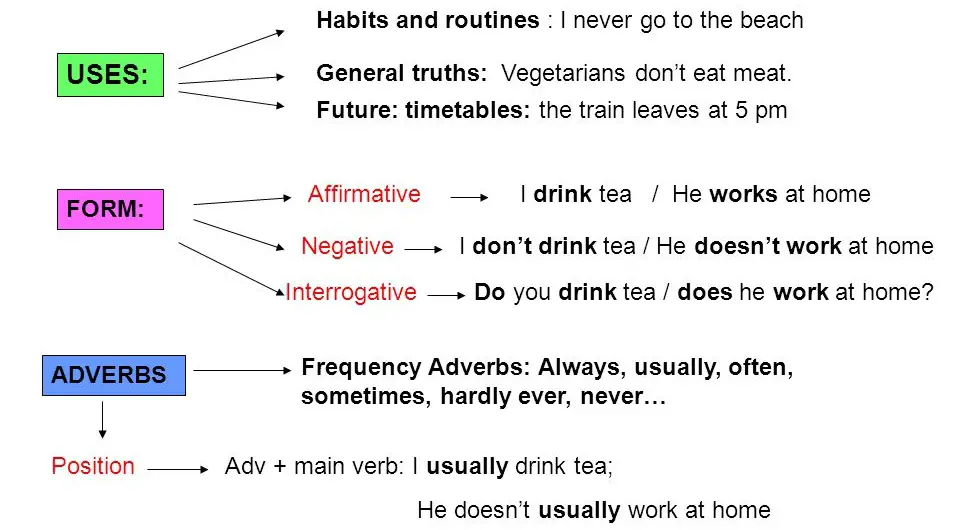THE Simple Present or simple present is a tense that we use to indicate habitual actions and recurring situations that occur in the present or in everyday life. It can also be used to Express feelings, desires, opinions, truths and preferences.
Its name is obvious and it means simple verbal form of the present. Phrases with simple present usually accompany expressions of time (adverbs) such as:
Tabela Responsiva: Role a tabela para o lado com o dedo <<
| now | agora |
| always | sempre |
| today | hoje |
| never | nunca |
| every day | todos os dias |
| often | frequentemente |
| daily | diariamente |
| sometimes | às vezes |
| every morning | todas as manhãs |
For you to see how the Simple Gift it's a simple thing, let's see some examples below:
Tabela Responsiva: Role a tabela para o lado com o dedo <<
| I run | Eu corro |
| You run | Você corre |
| We run | Nós corremos |
| I always run | Eu sempre corro |
| She kisses | Ela beija |
| She daily kisses | Ela beija diariamente |
| She often does | Ela faz frequentemente |
| It dies | Ele morre |
| He enjoys | Ele gosta |
| It plays | Ele/ela brinca |
| Babies cry | Bebes choram |
Simple present rules and tips
Now that you have seen several examples above, be aware of some rules that you can observe in these examples:
- Verbs change when he, she and it are used. An “S” is added at the end of the verb.
- When the verb ends in "O, S, SS, SH, CH, X or Z" you must add the ES instead of just an S.
- When the verb ends with consonants before the Y, you must remove the Y and add HEI in place. [study = studies]
- The verbs in the simple present are used with the verbs in the infinitive, but without the “to” particle.
- The verb “to do” means to do. Already in simple present it is used as an auxiliary verb that complements the formation of negative and interrogative sentences.

Difference between simple present x present continuous? THE simple present describes a habitual action and occurred while the present continuous describes an action that is currently taking place or has just taken place.
Conjugation of the verb to be in Simple Present:
- I am (I'm)
- You are (You're)
- He is (He's)
- She is (She's)
- It is (It's)
- You are (You're)
- We are (We're)
- They are (They're)
The simple present also has a way of combining the verb to have.
Simple present example sentences
Now that you know the rules, let's see everything in practice with examples:
Tabela Responsiva: Role a tabela para o lado com o dedo <<
| Phrase in Portuguese and English | Frase em Português | Observação |
| The sky is blue | O céu é azul | Verdade Universal |
| He leaves his office at six o'clock. | Ele deixa o escritório às seis horas | Afirmativo |
| I don't understand what they say | Eu não entendo o que eles dizem | Negativo |
| Do they know about this? | Eles sabem sobre isso? | Interrogativo |
| Mary and I work together. | Mary e eu trabalhamos juntos. | Habitual |
| Jack lives in Canada. | Jack vive no canada. | Afirmativo |
| She go to church every sunday. | Ela vai para igreja todos os domingos. | Afirmativo |
| We don't have the time. | Nós não temos tempo. | |
| Don't cry for me. | Não chore por mim. |